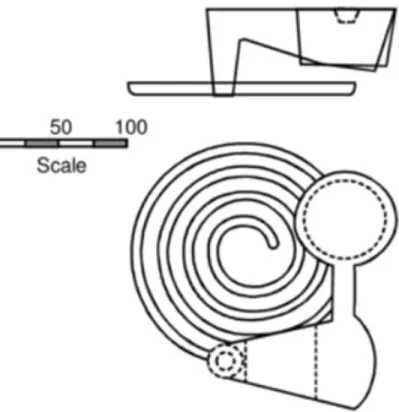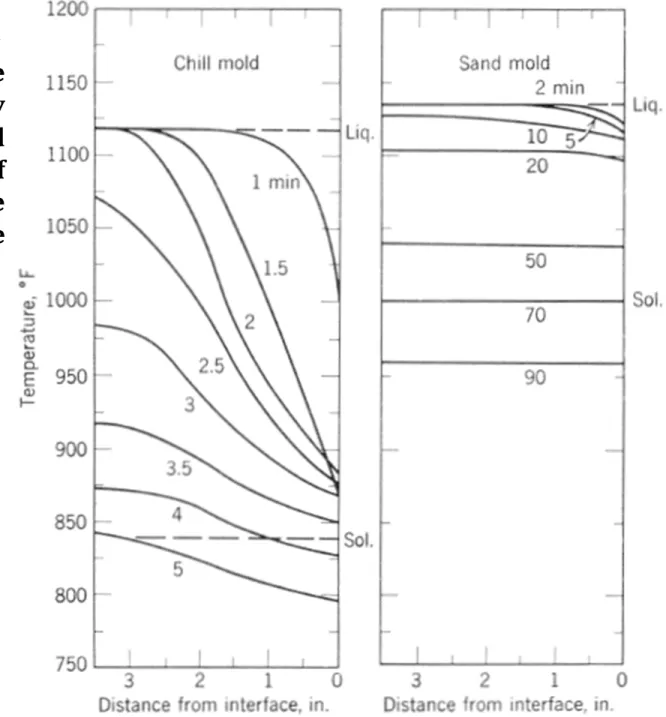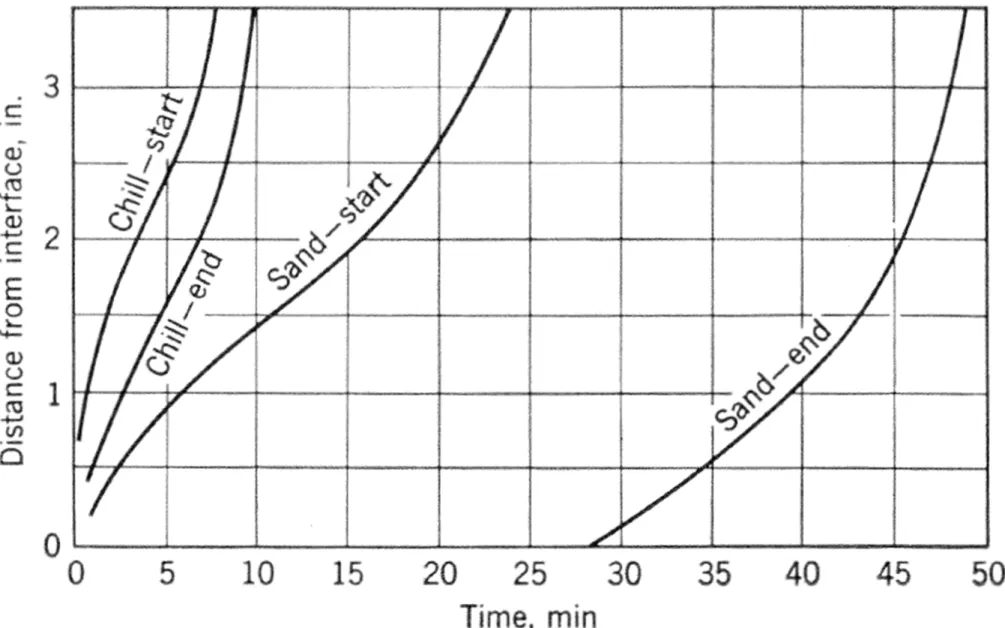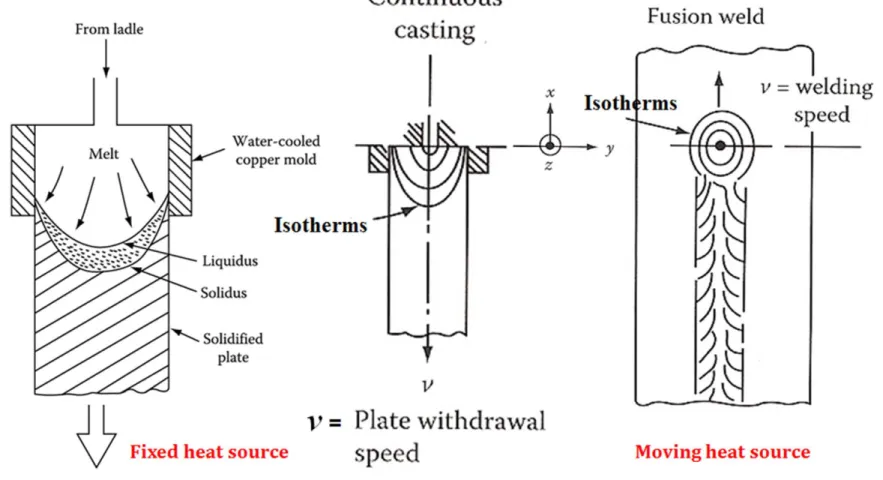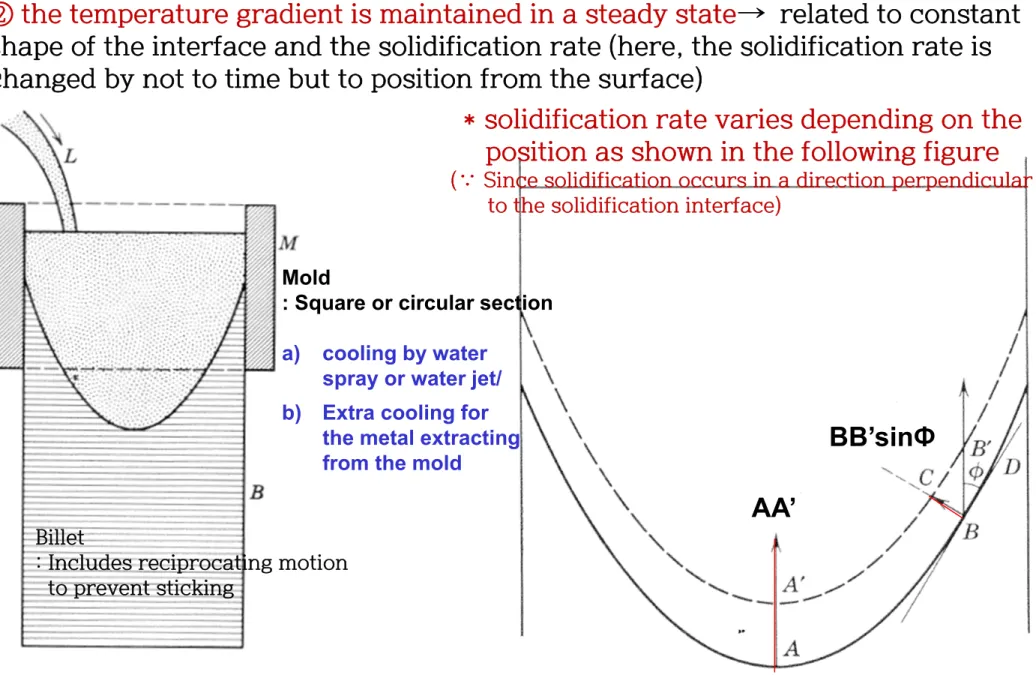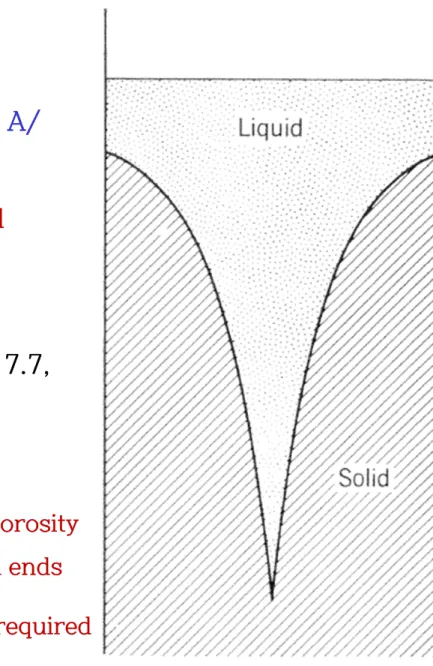Office: 33-313
Telephone: 880-7221 Email: [email protected]
Office hours: by appointment
2017 Fall
1
“Calculation and Applications Phase Equilibria”
Principles of Solidification
Eun Soo Park
06.12.2017
Stable
Metastable
12) Cast Iron: Fe-C alloy (1.7 ≦ c ≦ 4.5%)
Cementite
Eutectic
Eutectoid Peritectic
Ledeburite
Perlite
CAST IRONS
Grey CI Ductile CI White CI
Malleable CI
Alloy CI
Good castability C > 2.4%
Malleabilize
Stress concentration at flake tips avoided
* Two eutectic system: Fe-graphite (stable) & Fe-Fe3C (metastable)
: If there is no other additive element, the Fe-graphite system is stable
& Fe-Fe3C (cementite) eutectic is formed by rapid cooling of liquid phase
* Classification of Cast Iron is possible depending on the type of Carbon.
① Carbon → graphite
② Carbon → Fe3C
③ Carbon → Fe3C + cementite
Mottled CI
4 - L + α → β , difficult to complete.
- α dendrites first form at T1;
Liquid reaches the composition ‘c’;
β forms as the result of the peritectic reaction;
α coring is isolated from further reaction finally β + γ eutectic forms.
* Peritectic reaction (L + α → β) is a very slow reaction except for the initial state, because liquid and α are separated by β
5
6.4. Solidification in the presence of a solid phase
• Three factors that may influence the final location of a particle
(1) If “density” of particle is different from that of liquid: particle ~ float or sink - Particle behavior dominated by its buoyancy (positive or negative)
: depends on density difference and the size and shape of the particle
(2) Second factor = “Fluid motion“_ generated as the liquid enters the mold
large enough to maintain in suspension particles that would sink or float in a stationary liquid
: persist for a considerable time before it gives way to convection caused by thermal and composition gradient.
(3) Third factor = “Interface speed” : Although there may be some vertical separation due to flotation or sedimentation, and some radial separation resulting from centrifugal forces, the smaller particles may remain suspended with a nearly random distribution.
→∴ The final distribution in the solid depends on whether a particle is “trapped” in situ by the advancing S-L interface or whether it is pushed ahead as the interface moves forward.
6
7. Macroscopic Heat Flow and Fluid Flow 7.2. Fluid Flow
* The ability of a molten metal to flow =
(1) poured from a container in which it was melted into a mold in which it is to solidify.
(2) Relative motion of different parts of the liquid can occur while it is solidifying.
: its implications in relation to the structure of the solidified metal (Chapter 8)
1) Viscosity of liquid metal
liquid metal : “Flow rate depends on the force” = “shear rate is proportional to the shear stress”
: effect of the macroscopic geometry of the casting (Chapter 7)
* If the value of Reynolds’ number is high (>1400 ) for a tube leading out of a containing vessel, the flow becomes turbulent and Q drops below the value that would be calculated from the above formula. → Derive the “Kinematic viscosity, μ /γ” from the above equation : Used for calculation of flow rate when pressure difference is caused by flowing liquid → For solidification it is considered more important.
→ To compare “rates of flow”,
Reynolds’ number =
γ vl / μ
γ = density , v = velocity,μ = viscosity, l = linear dimension
7
Fragile network glass :Vogel-Fulcher relation
Strong network glass :Arrhenius behavior
]
0
exp[
RT E
a
] exp[
0
0
T T
B
< Quantification of Fragility >
Fragility
g n
g g T T
T n T
g d T T
T d
T T
d
T m d
( / )
) ( log )
/ (
) ( log
, ,
< Classification of glass >
Fragility ~ ability of the liquid to withstand changes in medium range order with temp.
~ extensively use to figure out liquid dynamics and glass properties corresponding to “frozen” liquid state
Slope of the logarithm of viscosity, η (or structural relaxation time, τ ) at Tg
8
*Bernoulli theorem:
Applicable for dynamic behavior of fluid_Fluid MechanicsBy assuming that fluid motion is governed only by pressure and gravity forces, applying Newton’s second law, F = ma, leads us to the Bernoulli Equation.
p/w + Z + q
2/2g = constant
along a streamline(p= pressure w = specific weight q = velocity g = gravity z = elevation)
In a steady flow, the sum of all forms of energy in a fluid along a streamline is
same at all points on that streamline: “principle of conservation of energy”
A streamline is the path of one particle of water. Therefore, at any two points along a streamline, the Bernoulli equation can be applied and, using a set of engineering assumptions, unknown flows and pressures can easily be solved for.
For a flowing liquid,
The pressure due to head of liquid
9
(a) At any two points on a streamline:
p
1/w + Z
1+ q
12/2g = p
2/w + Z
2+ q
22/2g
1 2
(b) If the fluid velocity, q, of the liquid increases, the pressure of the liquid decreases due to the effect of the passing tube. → ∴ In the case of liquid metals flowing through a complicated mold, the pressure decreases due to the influence of air bubbles entering the liquid phase from the mold wall and flowing together. These air bubbles cause internal void formation in casting.
10
Mold Filling
Bernouli’s Equation (incompressible flow):
Reynold’s Number:
• Short filling times
• Potential Turbulence
vDP Re
Z
γ = density , v = velocity,
μ = viscosity, l = linear dimension
(p= pressure w = specific weight q = velocity g = gravity z = elevation)
principle of conservation of energy
11
* Fluidity:
The ability of being fluid or free‐flowing_distinguished from viscosity : Maximum length melt can reachFig. 7.1. Mold for fluidity test.
12
New Design of Fluidity Test piece
13
Solidification Rate
14
Fluidity of short Freezing Range Alloys
① Effect of composition
15
Fluidity of Long Freezing Range Alloys
16
Mapping the Fluidity of Binary Alloys
Fluidity of Al-Sn alloys
17
The Fluidity of Al-Si alloys The Fluidity of Al-Zn alloys
18
The Fluidity of Al-Cu-Si Alloys
19
The Fluidity of ZA 27
Zinc-AluminumAlloy
② Effect of temperature
20
Comparison of Fluidity Measurements
21
Rationalisation of Fluidity Measurement
22
Continuous Fluidity
23
Regimes of continuous, partial and impossible flow
: Maximum length melt can reach
24
25
26
탕구
27
28
29
7.3. Heat Flow
* Solidification rate of solid/liquid interface ∝ ΔT = Te–T (actual temp): To maintain ΔT, latent heat generated during solidification needs to be removed.
→ the amount of solidification at a given time ∝ the amount of heat removed during that time, Q
* Heat transfer in the casting process
1) Thermal conductivity: Generally in pure metals and low alloys, TC decreases/ in high alloys TC increases when T increases/ TC of metal >> TC of ceramic.
2) Convection heat transfer: Convection occurs due to density difference by temperature difference in flowing of molten metal.
3) Radiative heat transfer: in high‐temperature molten metal or mold surface
contacting the atmosphere, radiation heat transfer in which heat energy moves in the form of electromagnetic waves should be considered.
4) Phase transformation and latent heat: Release or absorption of latent heat occurs when there is a phase transformation/ in this case, exothermic or endothermic term should be added by heat energy conservation law.
S S L L V
K T K T vL
Heat Balance Equation
* Heat diffusivity
b =
K= thermal conductivity/ γ = density/ C= specific heat
* n = (b of mold metal)/ (b of solidifying metal)
: Solidification of steel in cast iron mold n = 1.12 ~ close to 1.
* Possible to classify of various solidification processes according to thermal property of mold (Related to heat release associated with solidification rate)
a. For metal molds with thermal conductivity similar to solidifying metal
* If the metal mold thickness is not larger than the section thickness to be cast, Initial solidification: control by heat flow into mold
final solidification: Conduction through mold / Heat loss outside the mold
* 3 different types of metal mold
(1) Typical ingot mold: Heat release by radiation from outer surface and convection
(2) Metal mold cooled on surface relatively far from casting
→ - Most continuous casting is made by water cooling.
- Water cooling in the absence of mold has a similar effect.
- Arc melting also uses this type of mold.
(3) Huge metal mold compared to the solidification part
: Heat loss outside mold is not large until final solidification
Fig. 7.2. cross section of butt weld (schematic).
B. Sand mold: Thermal conductivity is much smaller than solidifying metal Ex) n = 0.13 → the dependence of the mold thickness is greatly reduced
(∵heat loss from the mold surface is independent of thickness variation) C. If the heat release is controlled by controlled heat supply control and heat sink to the liquid metal, as in the case of zone refining or single crystal growth: the
process rate depends on the L‐S temperature gradient and the interfacial velocity, v.
1. Solidification Rate
* The solidification rate f(t) is to obtain the increase in time of the solid layer in contact with the mold. Although in case of pure metal or eutectic without solidus‐
liquidus interval, it is possible to calculate the heat flow by solidifying while maintaining the planar interface, heat flow calculations and interpretation of results at the dendritic interface are complicated due to influence by various interface conditions → Solidification rate can be calculated by measuring the Temp.‐time relationship in various parts of the solidifying metal.
34
Assumption: mold and metal: semi-infinite / initial liquid temperature Tm / liquid: pure metal
& solid-liquid interface temperature~ constant / metal: constant temperature with mold interface
① For heat conduction in one direction in the mold (i.e., perpendicular to the planar mold wall),
Temp, θof an element of volume at t
② ΔT at a specific location in time t :
initial temp. at the surface, θ0 → instantly raised to θi at t=0 → change to θm at t=t1
③ Heat removed by casting at any time t1 :
④ Total heat conducted into the mold Q up to time t : (where, b = )
Thermal conductivity
density Heat capacity
where,
By differentiation of the efrc equation
⑤ Thickness of the solidified layer, D:
⑥ Reflection of Superheat condition: more complicated problem Total heat to be extracted
from solidifying metal =
→ This amount of heat must be conducted into the mold during the time t taken for solidification.
If the area of the surface of contact of mold and metal is A, then
(Chvorinov’s rule)
where, q = solidification constant
L: latent heat/ density of solidified metal: γ’
Solidification Time
• Total solidification time T
TS= time required for casting to solidify after pouring
• T
TSdepends on size and shape of casting by relationship known as Chvorinov's Rule
where T
TS= total solidification time; V = volume of the casting; A = surface area of casting; n =
exponent with typical value = 2; and C
mis mold constant.
n
TS m
T C V
A
Mold Constant in Chvorinov's Rule
• Mold constant C
mdepends on:
– Mold material
– Thermal properties of casting metal
– Pouring temperature relative to melting point
• Value of C
mfor a given casting operation can be based on experimental data from previous
operations carried out using same mold material,
metal, and pouring temperature, even though the
shape of the part may be quite different
What Chvorinov's Rule Tells Us
• Casting with a higher volume-to-surface area ratio cools and solidifies more slowly than one with a lower ratio
– To feed molten metal to the main cavity, T
TSfor riser must be greater than T
TSfor main casting
• Since mold constants of riser and casting will be equal, design the riser to have a larger volume-to-area ratio so that the main casting solidifies first
– This minimizes the effects of shrinkage
39
Surface 1 area
2time tion
Solidifica
6 6
and , 1
, 2
3
a a A a
V
4 . 2 5
6 1 6
2 2
2 , 1
2
3 2 2
2
3 1 3
2
r rh
r A
r r h
r V
C t
C t
C
t
sphere 0 . 043 ,
cube 0 . 028 ,
cylinder 0 . 033
84 . 4 4
4 3 4
4 , 3
3 4
3 2 2
3 1 3
r A
r r V
Solidification times for various shapes
Three metal pieces being cast have the same volume but different shapes: On is a sphere, one a cube, and the other a cylinder with its height equal to its diameter.
Which piece will solidify the fastest, and which one the slowest? Assume that n = 2 Solution The volume of the piece is taken as unity. Thus from Eq.
The respective surface areas are as follows:
Sphere: Cube:
The respective solidification times are therefore
Hence, the cube-shaped piece will solidify the fastest, and the spherical piece will solidify the slowest.
Cylinder:
Fig. 7.3. Variation of temperature during solidification of Al 5% Mg alloy in a 7-inch square mold. (a) Metal mold, (b) sand mold.
* In the case of sand mold, The superheat of the liquid phase is uniformly reflected throughout and delays the start of solidification until the liquid reaches the liquidus temp.
* Thickness of the
solidified layer D in sand mold casting
Fig. 7.4. Movement of liquidus and solidus tempeeratures during 41 solidification of a 0.6% carbon steel.
42
2. continuous casting :
a number of dynamic industrial process The molten metal is poured continuously into a water-cooled mold from which the solidified metal is continuously withdrawn in plate or rod form. (solid-liquid interface)(a)
(b) (c) (d)
43
continuous casting
44
continuous casting
45
4.4.3 continuous casting
46
Fig. 4.44 Schematic illustration
of a continuous casting process Fig. 4.45 Illustrating the essential equivalence of isotherms about the heat sources in fusion welding and continuous casting
continuous casting :
a number of dynamic industrial process : large mass (economic advantage)/ high speed (property good)→ Process speed: related to latent heat removal & metal flow during solidification.
① Dynamic process: importance of isotherm distribution
continuous casting :
a number of dynamic industrial processMold
: Square or circular section a) cooling by water
spray or water jet/
b) Extra cooling for the metal extracting from the mold
Billet
: Includes reciprocating motion to prevent sticking
Fig. 7.5. Continuous casting (schematic). Fig. 7.6. Interface shape and rate of solidification in continuous casting.
② the temperature gradient is maintained in a steady state→ related to constant shape of the interface and the solidification rate (here, the solidification rate is changed by not to time but to position from the surface)
* solidification rate varies depending on the position as shown in the following figure
(∵ Since solidification occurs in a direction perpendicular to the solidification interface)
AA’
BB’sinΦ
Fig. 7.7. Alternative interface shape in continuous casting
* To obtain the interface shape of Fig. 7.6,
in the case of max. emission of latent heat at A/
min. emission of latent heat at D
→ For this, efficient cooling of the billet beyond the mold is necessary.
* To obtain solid-liquid interface shape of Fig. 7.7, At the billet center, the solidification rate
becomes minimum.
→ In this case. a large tendency of segregation and porosity by shrinkage in the center line where solidification ends
→ additional cooling of the lower part of the mold is required
